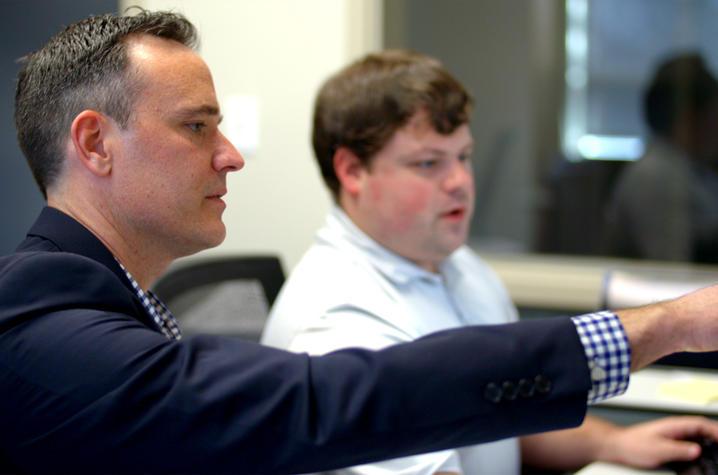LEXINGTON, Ky. (March 8, 2022) — Organic semiconductors, often referred to as plastic electronics, offer key advantages for emerging electronic and communication devices, provided they can meet all the appropriate metrics for performance, stability and cost. While these materials are already widely used in display technologies — the organic light-emitting diodes used as the displays in televisions, tablets, smart phones and watches are the foundation of a multi-billion dollar per year industry — there remain several technical hurdles to widespread market adoption.
Two faculty members in the University of Kentucky College of Arts and Sciences’ Department of Chemistry, who also serve as affiliated faculty members at the Center for Applied Energy Research (CAER), are using a different approach to accelerate market adoption.
UK’s John Anthony and Chad Risko, along with collaborators Oana Jurchescu at Wake Forest University and Yueh-Lin "Lynn" Loo at Princeton University, have received a Special Creativity Award by the National Science Foundation Designing Materials to Revolutionize and Engineer our Future program for their project titled Organic Semiconductors by Computationally Accelerated Refinement (OSCAR).
One key question for chemists is how to design both the building blocks of these materials and the processes by which they are assembled to be able to control the performance. While trial-and-error approaches — make a material, test it, refine the approach and repeat — are still widely used throughout science in general, Anthony and Risko are creating a unique, technology-forward concept. They are developing computer models that can be used to explore the wide chemical space of organic semiconductors to first predict what should be made.
The multidisciplinary team of chemists, physicists and engineers in OSCAR have forged a transdisciplinary approach to build the understanding needed to reach the goal of machine-informed materials design. In addition to continuing the development of a publicly accessible data structure and models to predict new materials based on advances in machine learning, a key outcome of the Special Creativity Award is to develop new materials for radiation sensing for biomedical applications.
“The design and optimization of new electronic materials is extremely time consuming and can generate substantial amounts of chemical waste,” Anthony said. “Using computational studies to aid material design has significantly reduced the trial-and-error processes normally required to optimize materials for specific applications. In this case, the design of new materials for light, flexible x-ray detectors will revolutionize quality control in manufacturing and enhance the use of radiation in medical diagnostics and therapies.”
The objective of the award is to offer the most creative investigators an extended chance to attack adventurous, “high-risk” opportunities in the same general research area, but not necessarily covered by the original/current award.
“This is the perfect example of why we have made strategic investments in our organic materials team,” said Rodney Andrews, director of the UK Center for Applied Energy Research. “By bringing in Chad Risko and his computational chemistry expertise to supplement the established strength of John Anthony’s organic chemistry capabilities, we had hoped to receive awards like this. Kudos to both the Anthony and Risko laboratories for this award and their continued innovation.”
Research reported in this publication was supported by the National Science Foundation under Award Number 1627428. The opinions, findings, and conclusions or recommendations expressed are those of the author(s) and do not necessarily reflect the views of the National Science Foundation.
The University of Kentucky is increasingly the first choice for students, faculty and staff to pursue their passions and their professional goals. In the last two years, Forbes has named UK among the best employers for diversity, and INSIGHT into Diversity recognized us as a Diversity Champion four years running. UK is ranked among the top 30 campuses in the nation for LGBTQ* inclusion and safety. UK has been judged a “Great College to Work for" three years in a row, and UK is among only 22 universities in the country on Forbes' list of "America's Best Employers." We are ranked among the top 10 percent of public institutions for research expenditures — a tangible symbol of our breadth and depth as a university focused on discovery that changes lives and communities. And our patients know and appreciate the fact that UK HealthCare has been named the state’s top hospital for five straight years. Accolades and honors are great. But they are more important for what they represent: the idea that creating a community of belonging and commitment to excellence is how we honor our mission to be not simply the University of Kentucky, but the University for Kentucky.

 By
By